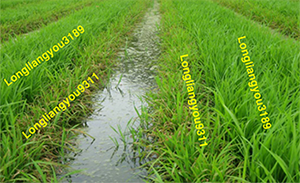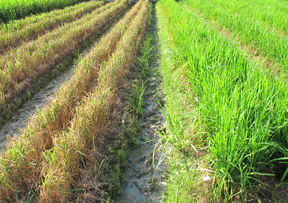Molecular Mechanisms of Plant-environment Interactions
The main research focuses on the molecular mechanisms of plant disease resistance and defense, plant-microbes symbioses, plant environmental epigenetics and plant metal stress biology, with the aim to provide an important foundation for plant biology research and guidance for plant molecular breeding.
Primary Scientific Discoveries
Epigenetic regulation of antagonistic receptors confers rice blast resistance with yield balance Crop breeding aims to balance disease resistance with yield, however single resistance (R) genes can lead to resistance breakdown and R gene pyramiding may impact growth fitness. Here the research group led by Dr. Zuhua He reports that the rice Pigm locus contains a cluster of genes encoding nucleotide-binding leucine-rich repeat (NLR) receptors that confer durable resistance to the fungus Magnaporthe oryzae without yield penalty. In the cluster, PigmR confers broad-spectrum resistance, whereas PigmS competitively attenuates PigmR homodimerization to suppress resistance. PigmS expression and thus PigmR-mediated resistance are subjected to tight epigenetic regulation. PigmS increases seed production to counteract the yield cost induced by PigmR. Therefore, their study reveals a mechanism balancing high disease resistance and yield through epigenetic regulation of paired antagonistic NLRs, providing a tool to develop elite crop varieties.
Crop breeding aims to balance disease resistance with yield, however single resistance (R) genes can lead to resistance breakdown and R gene pyramiding may impact growth fitness. Here the research group led by Dr. Zuhua He reports that the rice Pigm locus contains a cluster of genes encoding nucleotide-binding leucine-rich repeat (NLR) receptors that confer durable resistance to the fungus Magnaporthe oryzae without yield penalty. In the cluster, PigmR confers broad-spectrum resistance, whereas PigmS competitively attenuates PigmR homodimerization to suppress resistance. PigmS expression and thus PigmR-mediated resistance are subjected to tight epigenetic regulation. PigmS increases seed production to counteract the yield cost induced by PigmR. Therefore, their study reveals a mechanism balancing high disease resistance and yield through epigenetic regulation of paired antagonistic NLRs, providing a tool to develop elite crop varieties.
This work entitled "Epigenetic regulation of antagonistic receptors confers rice blast resistance with yield balance" was published in Science (Deng et al., 2017, 355: 962-965).
"Exciting biology" rewrites text books in uncovering high-fat diet for fungi Arbuscular mycorrhiza (AM) formation is a widespread symbiotic interaction between 80-90% of land plants and soil fungi. The plant benefits from enhanced inorganic nutrient supply mediated by the fungal hyphae network in the soil. In return, from the plant, the fungi draw organic nutrients which are thought to be supplied primarily in the form of sugars. However, within the fungus, most carbon is stored in lipids that are transported throughout the mycelium. The research group led by Dr. Ertao Wang shows that the AM fungus Rhizophagus irregularis is a fatty acid auxotroph and fatty acids synthesized in the host plant are transferred to the fungus during AM symbiosis. They find that the transfer is dependent on the RAM2 (Required for Arbuscular Mycorrhization 2) and peri-arbuscular membrane-localized ATP binding cassette (ABC) transporter-mediated plant lipid export pathway. Their study further proves that fatty acids synthesized in plants also can be transferred to the pathogenic fungus Golovinomyces cichoracerum. Plants defective in fatty acid biosynthesis are impaired in AM symbiosis and show defects in colonization by the pathogenic G. cichoracerum.
Arbuscular mycorrhiza (AM) formation is a widespread symbiotic interaction between 80-90% of land plants and soil fungi. The plant benefits from enhanced inorganic nutrient supply mediated by the fungal hyphae network in the soil. In return, from the plant, the fungi draw organic nutrients which are thought to be supplied primarily in the form of sugars. However, within the fungus, most carbon is stored in lipids that are transported throughout the mycelium. The research group led by Dr. Ertao Wang shows that the AM fungus Rhizophagus irregularis is a fatty acid auxotroph and fatty acids synthesized in the host plant are transferred to the fungus during AM symbiosis. They find that the transfer is dependent on the RAM2 (Required for Arbuscular Mycorrhization 2) and peri-arbuscular membrane-localized ATP binding cassette (ABC) transporter-mediated plant lipid export pathway. Their study further proves that fatty acids synthesized in plants also can be transferred to the pathogenic fungus Golovinomyces cichoracerum. Plants defective in fatty acid biosynthesis are impaired in AM symbiosis and show defects in colonization by the pathogenic G. cichoracerum.
Their results also reveals that pathogenic fungi similarly recruit the fatty acid biosynthesis program to facilitate host invasion, and regulating fatty acid availability to fungus might provide an effective tool to control pathogenic fungus infection in crops.
This work entitled "Plants transfer lipids to sustain colonization by mutualistic mycorrhizal and parasitic fungi" was published in Science (Jiang et al., 2017, 356: 1172-1175).
Regulation mechanism of important physiological traits of rice and application basis of molecular breeding —— The Second Prize of National Natural Science Award (2014)
Principal Achievers: Zuhua He, Ertao Wang, Jianjun Wang, Yingying Zhang, Yiwen Deng
- This study revealed the regulation and domestication mechanism of complex physiological traits in rice grain filling, which laid a foundation for promoting grain filling and improving yield potential of gramineous crops (Nat Genet, 2008);
- The research team elucidated the physiological and molecular mechanisms of internode elongation regulation in rice and established a new pathway for GA metabolism and trait regulation. (Plant Cell, 2006);
- The team systematically carried out researches on the physiology and molecular mechanism of rice disease resistance, and made important breakthroughs in the discovery of broad-spectrum disease resistance genes, which promoted the research and application of rice molecular breeding.


